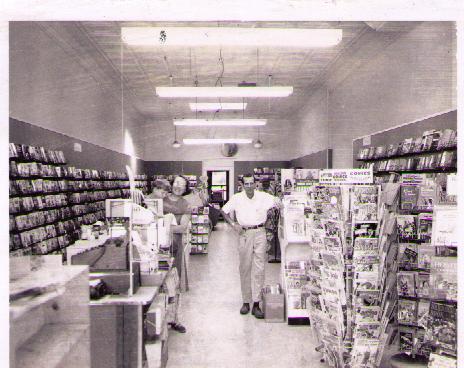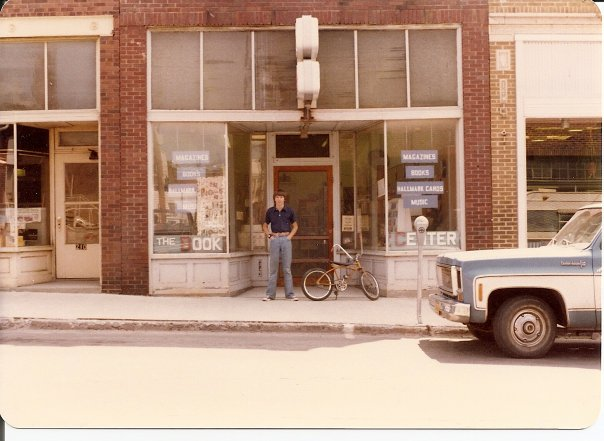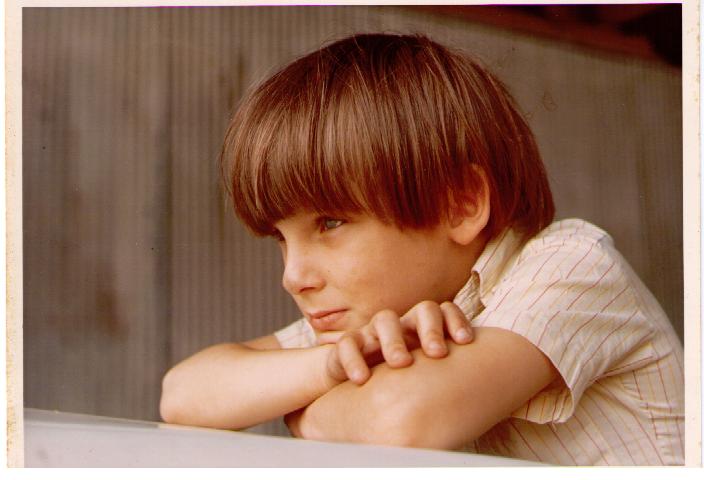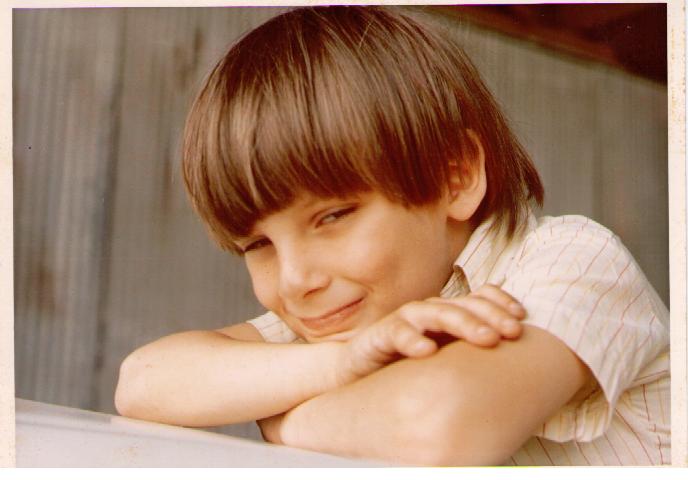I’ve been meaning for a long time to write about the back room of our family’s bookstore, The Book Center (1970?-1984). I am uncertain about the exact starting date because this location known to those who remember the store at all was actually its second location. The Book Center began in (I think) 1967 about a block east of the Square on Main Cross Street. After one, two, or three years, it moved to the familiar address, 212 West Market Street, between Eddy’s Studio and the CIPS building, in the same block as the old public library.
Describing the entire store would be too much for a single blog post, but I’ll try to convey something of that magical headquarters that was its back room, my family’s in-town base, where friends and I spent much of our childhood.
First, there was a battered wooden desk, positioned to command a view up the center aisle of the main store, clear to the front door. This was helpful to my parents: whichever of them wasn’t up at the counter could work at the desk and have a pretty good idea of when extra help might be needed in front. This desk looked as if it had been through a war. First, it was nicked and hacked, as with the sawings of knives and the blows of hatchets. One couldn’t write on a piece of paper on its surface, because the pen would sink into a gouge, piercing a hole in the page. Fortunately, there were clever trays that slid out above the top drawer on each side, just for writing, and these (as I remember) were smooth. Second, the desk was absolutely covered in graffiti, words and numbers laid one atop another, garbled, running together. The desk must have been in the room when my parents rented the building. Because it was in such a condition, we kids were allowed to add to the graffiti at will, and we did. I can still remember the squeak of those black felt-tip markers as we wrote out the names of characters from Watership Down and The Lord of the Rings. I read much of both those works sitting at that desk myself — and countless other books and comics.
On Friday evenings, our bookstore didn’t close at the usual 5:00 p.m. It stayed open till 8:30, and those were wondrous times! It would grow dark outside the windows, but the carnival of books went on in the warm glow of bright electric lighting (the back room itself was much dimmer than the main store — a kind of gentle, dusty cave it was). On Friday nights, we would have to eat supper at the store, and that was delightful! Often we’d pick up a pizza from Johnny’s, and my parents would take turns coming into the back room to eat. Yes — there at the battered desk. I loved being at the store into the night. 8:30 once seemed so late and wild . . .
Just in front of the desk stood a rolling metal cart with a percolator coffee pot. Dad would fill the system with grounds and water before leaving at night, so that when he arrived in the morning, he had only to turn it on. I’m sure the coffee wasn’t good, but it was abundant, and that was what mattered. Coffee was the default drink in our household. It was available throughout the day. You could always count on it.
Between that cart and the open doorway leading into the store were some shelves. I think they held things like rolls of cash-register paper, but it has faded into the mist of memory now. There was a pencil-sharpener mounted to the right of the door. Also in that area, we had a mop bucket with wringers, a wet mop, and an always-dry dust mop.
Then there was the ancient metal sink against the east wall, with a cloudy mirror hanging above it. What I most recall about the sink is that my parents, cleaning up after lunch, washed some seeds from an orange or tangerine down the drain. After a while, tiny green shoots poked up through the holes in the drain cover. The regular flow of water never daunted them. My dad, always full of curiosity and reverence for life, carefully extracted the plants with roots intact and replanted them in a flower pot. I remember that they thrived in the pot, and I think they were eventually transferred to the ground at home. I’m not sure what became of them after that. I doubt the Illinois climate was too hospitable.
Beside the sink — ah! Here the real wonder begins! — there was a table, about 8 feet by 6 feet in my memory. I’m guessing it was actually smaller than that. Things seem much larger to us as children, and adults seem older. Made of blonde-colored wood, it was a relic of the sewing (dressmaker’s?) shop that had once occupied the building. I think the table had housed a sewing machine, though the machine had been removed. What remained was an honest-to-goodness secret compartment in the table! You could stick your hand in through a complicated opening underneath and push open a panel in the tabletop, and you had a fantastic compartment for storing secret treasures. For a time in grade school, my friend John T. often hung out with me after school, and we would draw maps every day — maps of lost islands, lost solar systems, and cutaway diagrams of cave systems. We stored these in the compartment, and by the end of our adventures together, we had quite a stack of them. I think Mr. Brown Snowflake may have been in on that sometimes, too.
In the gap of about three or four feet between this table and the east wall there was a huge, haphazard mountain of empty cardboard boxes. Again, I’m sure my memory is making it bigger than it ever was. But for us kids, it was fascinating. It was a mountain range honeycombed with tunnels. We burrowed through it, descending to the depths under the table, climbing hidden stairways unknown to mortals. My parents inventoried books on the blonde table, and I think all empty boxes got piled in the mountain — so it was always changing in height and shape, like the mountains of bales in the hayloft at home. But that’s another story.
Oh — there was an antiquated cash register back there, too, which took two burly men to lift. It was from the pre-electric era. You depressed metal lever-keys and turned the crank handle. Numbers in the glass window at the top would spin to the appropriate digits. At the end, the cash drawer would spring open with the loud DING! of an internal bell. Woe to you if you were in the way!
To the left of the inventory table rested an enormous iron fan from a machine shop. Frustrated by some hot summer, Dad bought it from a guy somewhere in town — I remember going with him. This propeller was designed to go in a factory window, I think. It was about as tall as an adult’s shoulder. Dad built a wooden framework for it to prevent accidents, which would have been gruesome. Dad’s idea was that this fan, positioned in the back room, would be able to cool the whole store. That was probably true. But when it roared to life, book covers flapped, cards and magazines flew off the racks, counters shook, and dust-cones swirled from all the long-forgotten nooks. I don’t recall that we ever used the fan much.
I’m unclear on what filled the southeast corner. Some big, heavy piece of furniture, I think, not completely assembled, and with mirrors — and with more things stacked on it — but I couldn’t swear to it now. Somewhere back there, I think a giant old radiator hissed and warmed the room. Next came a cabinet with many drawers.
Just inside the back door, which led outside, was a square wooden platform. The back parking lot, you see, was some eight inches higher than the floors of the store; so there was this platform, with a ramp made of three parallel planks. Deliverymen could smoothly wheel dollies laden with book-boxes down the ramp to the floor. All this — platform, ramp, and floor — was painted a dusky blue-gray, and covered with decades of dust. I always went barefoot then, and my feet were tough as a hobbit’s and permanently black. I was a fantasy creature, the wild boy of the bookstore, who climbed through the insides of racks and frightened customers. You think I’m kidding.
One such deliveryman who made use of the ramp was the Pepsi man. Our store didn’t have a vending machine. Nope, the Pepsi was for our own use. Dad maintained a standing order, and every other week or so, the man would bring a wooden case or two of Pepsi in glass bottles. A few of these at a time would go straight into the refrigerator beside the door.
Near one edge of that platform, there was a broken board. No one ever fixed it. It slanted down, moored only at one end, leaving a space about four inches wide and a foot long. The fissure seemed to lead to much greater depths than the floor beneath the platform. We used to drop pebbles and other small objects down through the gap and speculate as to where they were going. I think we looked for them in the basement, but I don’t remember the results of our experiments.
The southwest corner is also nebulous now in the shadows of the past. But all along the west wall was a monstrous display case of wood and glass. This was buried under more empty boxes, wire racks, scales from a former candy store, and an assortment of other paraphernalia. When we kids would climb around up there, we always had the awareness that there was glass under our feet — glass surfaces enclosing dead spaces of air. If we should put weight on the glass, it would very likely crack and shatter and cause us to plummet to our deaths among lethal shards — so we took care. This case figured into Dragonfly — it’s there, during the fight scene in the Glassworks.
One more feature of that place was the unusual restroom. In the northwest corner, a toilet and sink were closed off from the rest of the room by a wooden partition wall that didn’t reach the ceiling — it was only about eight feet high, and the ceiling itself soared high above that, with a central skylight. You could go in and close the door, but you never felt you were really in a separate place from anyone who happened to be in the back room.
There was a scattering of folding chairs, metal frames with white vinyl-covered cushioned seats.
And that’s about all I remember of the place. Gray light filtered through the dingy skylight in the daytime. Affable shadows crowded close on Friday nights. The air was always murky in a good, comfortable way. Out-of-town relatives who arrived during business hours would find us there, so I recall many happy reunions around the desk. Most of all, I remember family, friends, and books. That wondrous room, I think, gave birth to many stories.



